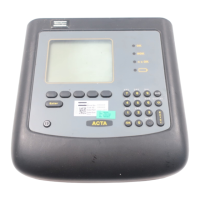Calibration
115
11.2 Calibrating Transducers with the ACTA 3000
Available in Basic, Quality Control and Advanced Analysis versions.
The ACTA 3000 has a built-in feature that allows calibration of transducers
using the deadweight method.
Note!
When performing this task, the use of certified deadweight equipment (arm and weight)
is needed.
In addition, if an Atlas Copco memory transducer is used and calibrated by means of
the above method, it will be possible to download the new calibration value to the
memory of the transducer directly from the ACTA 3000.
1. Place the transducer to be calibrated in the deadweight equipment.
2. Connect the transducer to the ACTA 3000.
3. Select transducer calibration by pressing the “Conf” softkey. Select “Calibration” and
“Deadweight” (Conf-3-2).
4. Select Deadweight by highlighting it and pressing ‘Enter’ or by pressing number 2 on
the keypad.
5. Select OK - press ‘OK’ on the keypad or highlight the OK icon followed by ‘Enter’.
6. A “Deadweight calibration” window appears with the following text:
Number of load points This is the current status of the number of full
measurements for your calibration.
No. of load points -> No. of cal. points.
No load on transducer Gives the required torque status of the transducer.
Measured value (mV/V) This refers to the numeric value below and
represents your measured mV/V value under the
current load on the transducer.
(Numeric value)
Below this window, three new functionality specific menu blocks appear for the
calibration process:
Save Lin.ch Cancel

